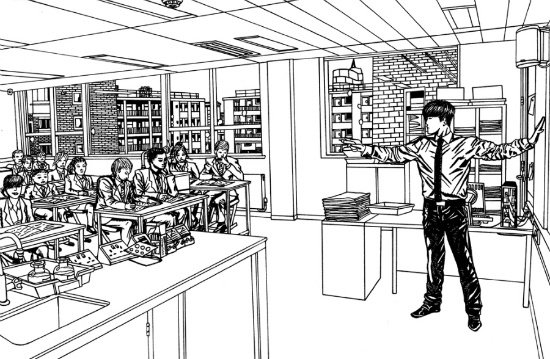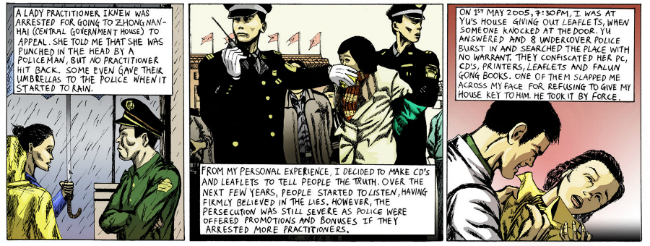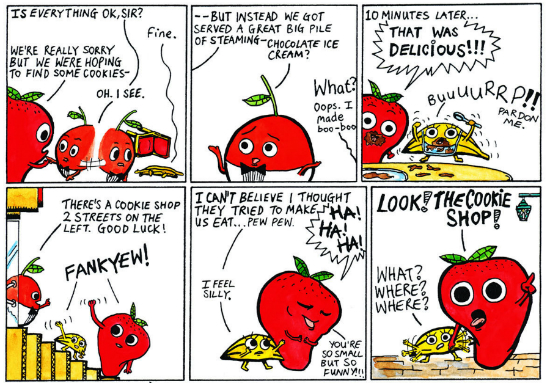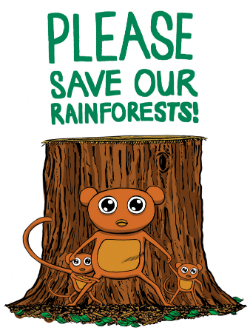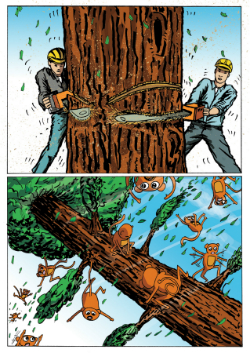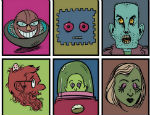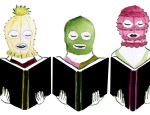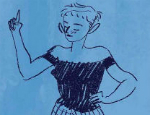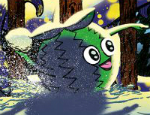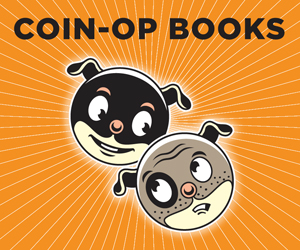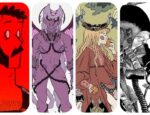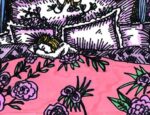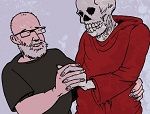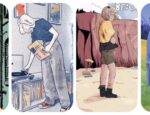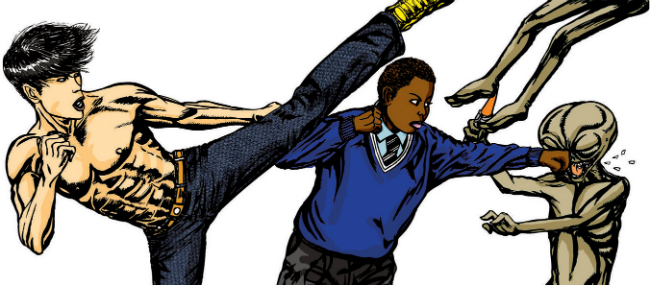 A creator unafraid to cross both genres and demographic appeal through his Illustrator: Lam imprint, Mickey Lam is a regular face at London’s small press comics fairs. His work ranges from strips targeted at a younger audience in the shape of the anthropomorphised fruity friends of Fwendly Fwuit to the manga sci-fi stylings of Mr. Yang Fights Aliens. Along the way he’s also tackled graphic journalism, topical commentary and parody. In the latest of my ‘Small Press Spotlight on…” series of interviews in this column, and fresh from a successful Comica Festival Comiket, I spoke to Mickey about his comics to date, his plans for the future and how to market yourself as a small presser…
A creator unafraid to cross both genres and demographic appeal through his Illustrator: Lam imprint, Mickey Lam is a regular face at London’s small press comics fairs. His work ranges from strips targeted at a younger audience in the shape of the anthropomorphised fruity friends of Fwendly Fwuit to the manga sci-fi stylings of Mr. Yang Fights Aliens. Along the way he’s also tackled graphic journalism, topical commentary and parody. In the latest of my ‘Small Press Spotlight on…” series of interviews in this column, and fresh from a successful Comica Festival Comiket, I spoke to Mickey about his comics to date, his plans for the future and how to market yourself as a small presser…
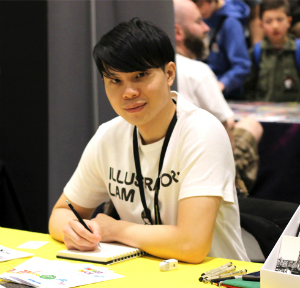 BROKEN FRONTIER: London small press enthusiasts will no doubt recognise your books given that you’re a regular presence these days at small press fairs but for our wider audience could you give us some background on your work as an artist and how, specifically, you became involved in the world of comics?
BROKEN FRONTIER: London small press enthusiasts will no doubt recognise your books given that you’re a regular presence these days at small press fairs but for our wider audience could you give us some background on your work as an artist and how, specifically, you became involved in the world of comics?
MICKEY LAM: I’m a self-taught artist who was inspired by the comic books I read as a child. I have taken some short art courses and life drawing classes too. I always felt that what comics could communicate was something unique, different to how a novel makes you feel after reading it, or a film after watching it.
BF: Your comics to date cover a diverse range of subject matter and approaches to the page, from the obvious manga influences of Mr. Yang Fights Aliens to the cartoony characters of Fwendly Fwuit. Is a constant experimentation with styles and different genres something you are consciously looking to develop in your work?
LAM: Absolutely. All these self-published comics are all in some way related to who I am, and one kind of story or genre is not the right place to express some things. People who know me personally can see my slapstick sense of humour through my Fwendly Fwuit and Andrew stories, but they can also see my dark and ‘street’ level humour in Mr. Yang. However to mix those types of humour wouldn’t go well, so I have to try different genres and styles. It’s also partly done to keep mixing things up for myself. I try to keep drawing different things and experimenting to keep things fresh.
BF: Mr. Yang Fights Aliens is your longer-form narrative, the first issue of which was reviewed here at Broken Frontier last year. The comic has a very straightforward direction in that the title and the premise are pretty much one and the same. Can you describe the basic set-up for the book and its cast of characters?
LAM: Definitely! Mr. Yang is a school teacher who hates the fact that it encroaches on his personal life far too much. Any high school teacher can relate to that, I’m sure (!). People deal with stress differently and for Mr. Yang, he’s pretty much at the end of his tether most of the time, especially as he’s missing a lot of social opportunities. In the midst of coping with this, he is kidnapped by aliens along with one of his school pupils, a homeless person and an elderly lady for the purposes of being dissected, so they have to work as a team to escape.
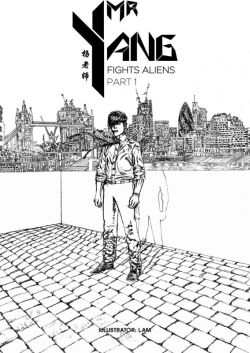 BF: Who do you count among your artistic inspirations on Mr. Yang Fights Aliens?
BF: Who do you count among your artistic inspirations on Mr. Yang Fights Aliens?
LAM: At the time there were two main influences. One was Ryoichi Ikegami (Crying Freeman). The manga energy you can feel from Mr. Yang comes from his way of drawing action scenes. The other was Yanick Paquette (Batman Incorporated) who has a very aesthetic line work. Other than that, as I used a lot of photographic reference, I tried to push myself and see what I could do.
BF: Mr. Yang is an intriguing protagonist in that he’s not overly sympathetic. For example, he’s more concerned about his social life than marking his pupils’ homework. What appealed to you about writing a hero who is such an acerbic individual, and what challenges are there in ensuring that your audience remains invested in such a blunt central character?
LAM: Ha ha! Mr. Yang has that kind of personality which I wish to develop more. He’s not really empathetic either. People who are usually blunt, direct, curt in real life may have a set of personal values from various life experiences that make them act that way, and I would like to explore that. Mr. Yang is like that because he struggles with his job responsibilities.
Also, for a writer, this kind of strong personality can be used to clash with other characters so the reader can see their different personalities. If all the ‘good’ guys are nice to each other and co-operative in a story, it makes for bland reading. The third reason I wanted Mr. Yang to have a blunt personality is that it makes for great comedy. Even if you don’t like the main protagonist, so long as you’re chuckling, it’s most likely you’ll be interested in seeing what happens next.
BF: You have also tried your hand at topical comics with a biography of Annie Yang for the Alternative Press’s Publish You anthology (read the whole comic online here). Can you tell us about the circumstances behind her persecution for practising the spiritual discipline of Falun Gong and why you think graphic journalism is such a powerful tool for communicating stories like Annie’s?
LAM: China is a communist country which is very tightly monitored by the government. Falun Gong was made public in 1992 and it grew in popularity until in 1999, it was estimated by an official government report that there were around 70 million people practising. Under orders of Jiang Zemin, then Premier of China, the Chinese communist party (CCP) launched a persecution against Falun Gong practitioners. As the number exceeded the members of the CCP, Jiang Zemin targeted Falun Gong for fear that such a large group would undermine his power. He began a campaign that tortured, killed and raped ordinary Chinese citizens for their beliefs. There have even been some allegations of live organ harvesting.
Although other religious and spiritual groups are persecuted such as Tibetan monks, Muslims and some Christian groups, Falun Gong is the most targeted because it is the largest. (There’s more detailed information at www.faluninfo.net)
Graphic journalism lets the humanity come through more so than prose. It provides the reader with a visual so that you can imagine what is going on. When you see the panels of Annie’s face, it cements that she’s a real person and this is exactly what she looks like, and when you continue to read, you start imagining and feeling for this person. It’s wholly more personal and involving. For me, this piece is different to my other work in that it’s about something awful that is still going on in the world and I wanted to expose that. The rest of my books are mainly done with entertainment in mind.
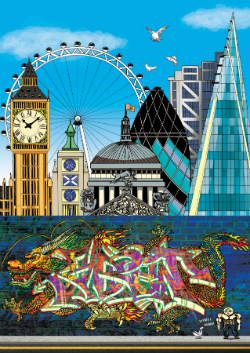 BF: You’ve recently been at work on a graffiti art piece for an upcoming project. How did you prepare for that in terms of your approach to a very different discipline and are there any teasers you can give us for the comic it was created for?
BF: You’ve recently been at work on a graffiti art piece for an upcoming project. How did you prepare for that in terms of your approach to a very different discipline and are there any teasers you can give us for the comic it was created for?
LAM: Yes, graffiti involves a very different way of seeing to create that kind of work. I did some ‘research’ on the kind of thinking involved in that creative process. The main gist I understood in graffiti work is thinking of letters not as letters but as shapes that can be warped and combined with different types of serifs. The word itself can be a mixture of upper and lower case letters, to create a specific aesthetic. It’s actually for Andrew, a recent comic I did. I thought I’d round out that project with a nice poster (right), which I will include in its next printing. As I’ve recently been more involved with exhibiting at small press, and seeing other artists’ work, it has made me want to push myself and try different kinds of art.
BF: Fwendly Fwuit is your all-ages comic strip series. Who are the characters who inhabit that world and what have reactions been like to their adventures from the comic’s younger target audience?
LAM: Children absolutely love it! It’s about a banana and a strawberry who become best friends and go on silly adventures. It’s my most popular book across all ages. Not only kids, but I’ve had guys buying it for their girlfriends, husbands for their wives and kids, and guys buying for their girlfriends and then reading it for themselves. Sometimes when I take a break from my stall, as I’m walking round, I’ve walked past guys who couldn’t not read it there and then after they bought it.
Because of this, I’m going to do another one! This will be a Fwendly Fwuit Winter Adventure, that I’m going to try get done for Thought Bubble later this year.
BF: Perhaps your most idiosyncratic comic to date is Andrew. It’s a book that bills itself as slice-of-life storytelling on “the most remarkable man to have lived in Deptford” but is replete with comedic flights of fancy. What was the basis for this rather eccentric minicomic?
LAM: Andrew is actually a parody based on my landlord! I was feeling in the mood to do a quick project on something different, so I turned his life and thoughts into a comic book with some exaggeration. After I finished it, I thought it would be a shame to just leave it in the drawer, so I made it available for everyone. I’ve had quite a few guys named Andrew who’ve flicked it through purely because they want to know about the life of another Andrew!
BF: As an emerging small presser what do you see as the main obstacles in getting your work seen by a greater audience? What lessons have you learnt along the way?
LAM: I’ve learnt a whole heap of things regarding self-promotion over the last year. The first being to make yourself visible, by going to lots of cons and exhibiting your work, you can get to know people. The more times people see you, the more they’re likely to remember you.
When I first finished Mr. Yang and wanted to promote it, I did a lot of emailing where I asked if someone would like to review my book. It’s tough because no one knows you or your stories at first, but persistence and patience pay off for sure.
Websites like Broken Frontier have done a great job in making the small press community more accessible. I’ve discovered a lot of really good reads that I never would have heard of otherwise! More coverage by comic book websites of more local indie artists would help in giving small pressers more exposure.
BF: And outside of your current projects are there any new characters or concepts you’re in the process of bringing to life?
LAM: Please Save our Rainforests is a short comic I’ve been working on. It’s about the cruel treatment monkeys have received at the hands of poachers and illegal tree loggers for money. It focuses on the monkey’s perspective. Other than that, I’m really happy with my current comics and am now planning sequels to them all.
For more on Mickey Lam’s work check out his site here and his online store here.
For regular updates on all things small press follow Andy Oliver on Twitter here.





